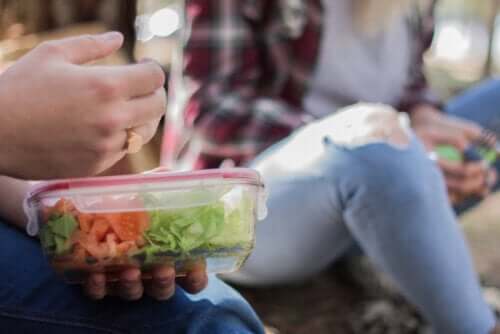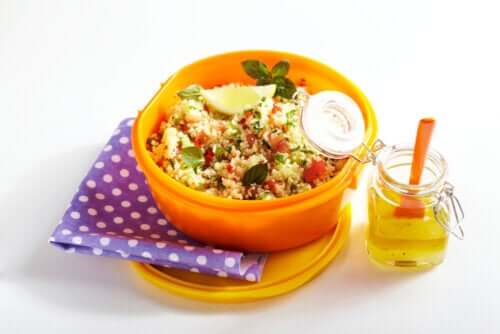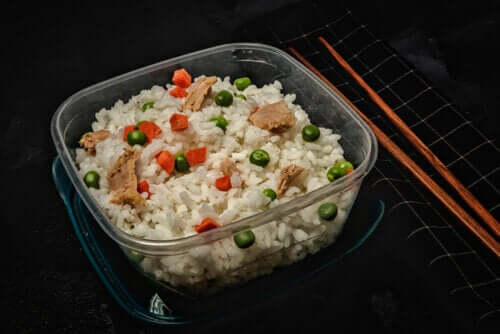How to Prepare a Healthy Lunch Box

More and more people are taking their lunch to work. However, there’s a tendency to eat quickly and use the same dishes, so it becomes monotonous and unhealthy. With that in mind, we’re going to give you some tips to make your lunch box healthy, varied and simple.
How to prepare a healthy lunch box
First of all, the easiest way to make a healthy lunch box is to follow the healthy eating plate suggested by Harvard University. It consists of dividing the plate into 3 parts corresponding to the 3 main food groups. Here’s the distribution:
- Half should be full of greens and vegetables. It’s advisable to include at least 3 different colors. This will make it more attractive.
- A quarter is made up of protein foods, such as eggs, legumes, fish and meat.

- The other quarter has farinaceous foods, such as potatoes, sweet potatoes, rice, pasta, bread, quinoa, millet and other cereals. The best option is whole grains, as they’re more satiating due to their high fiber content. In addition, they’ll keep you energized throughout the afternoon. Keep in mind that, if you include legumes, it’s not necessary to have cereals as well in the same meal.
It’s also advisable to include fruit as a dessert or some natural yogurt, drink water and use virgin olive oil. To complement it, add some nuts, olives or seeds. In addition, you can vary the cooking techniques and use herbs and spices to enhance the flavor.
How to keep it fresh until lunch time
- Store it in a container, preferably glass and microwave safe with a hermetic seal.
- Place it in the fridge as soon as you get to work. In this way, you avoid the risk of microorganisms that can cause food poisoning.
- Heat it in the microwave just enough to reach 75ºC (167ºF).
- Always carry the dressing separately to prevent the greens from spoiling.
Emergency resources
Next, we recommend the following foods in order to save time in the kitchen:
- Bags of mixed greens.
- Fresh fruits and vegetables, such as cherry tomatoes and avocado.
- Frozen or microwavable vegetables.
- Canned vegetables (mushrooms, grated carrots, asparagus, roasted peppers, corn, etc.).
- Canned fish and shellfish in olive oil or all natural.
- Pickles (olives, gherkins, onions, capers, etc.).
- Already cooked rice or quinoa cups.

- Cooked vegetables.
- Cheese slices or in cubes.
- Sprouts.
- Whole nuts.
Ideas for a healthy lunch box
Finally, remember that not everything is pasta, rice and salads. There are also multiple options like the ones below:
- Monday: Green beans, potatoes, tomatoes, onions and tuna salad.
- Tuesday: Steamed broccoli with walnut gremolata and grilled salmon with rosemary. To make the gremolata, just chop the walnuts and mix with parsley and lemon zest.
- Wednesday: Chicken curry sautéed with peppers, zucchini and quinoa.
- Thursday: Fried rice with carrots, peas and omelet.
- Friday: Sautéed chickpeas with pumpkin and spinach.
So, how easy is that?!
All cited sources were thoroughly reviewed by our team to ensure their quality, reliability, currency, and validity. The bibliography of this article was considered reliable and of academic or scientific accuracy.
- Universidad de Harvard. El plato para comer saludable.
- Miniesterio de Sanidad, Servicios Sociales e Igualdad. De tu cocina a la oficina. [Consultado el 25 de febrero de 2020] Disponible en: http://www.aecosan.msssi.gob.es/AECOSAN/docs/documentos/publicaciones/seguridad_alimentaria/cocina_oficina.pdf
- Universidad de Navarra. Decálogo tupper sano y seguro. [Consultado el 25 de febrero de 2020] Disponible en: https://www.unav.edu/documents/10759777/10808288/decalogo_tupper_1718.pdf/e3b6811a-75d7-a8ba-fe68-d63dc4814449
- El Comidista. Tres tápers para comer de lujo en el trabajo. Publicado el 1 de marzo de 2017. [Consultado el 25 de febrero de 2020] Disponible en: https://elcomidista.elpais.com/elcomidista/2017/02/23/receta/1487872491_670865.html
- Sara Kiyo Popowa. Recetas equilibradas para fiambreras: Bento Power. Editorial Blume, 2019.
- Agencia Salut Pública de Cataluña (ASPCAT). (2012) Dinars de carmanyola a l’entorn laboral. [Consultado el 25 de febrero de 2020] Disponible en: http://salutpublica.gencat.cat/web/.content/minisite/aspcat/promocio_salut/alimentacio_saludable/02Publicacions/pub_alim_entorn_laboral/dinars_carmanyola_a_la_feina/aspcat_dinars_carmanyola_entorn_laboral.pdf